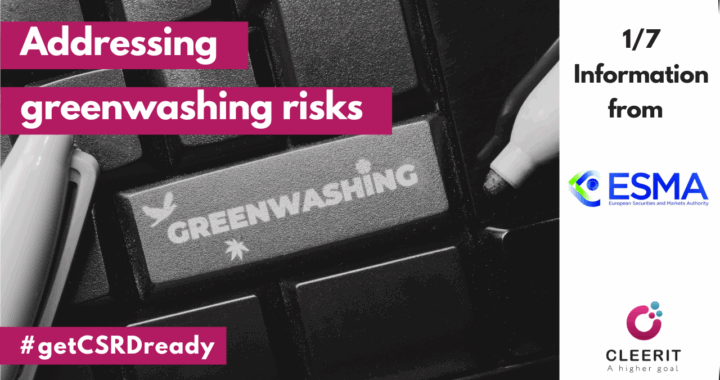On July 1st, ESMA published thematic notes on clear, fair & not misleading sustainability-related claims, addressing greenwashing risks in support of sustainable investments.
This is valuable information for any company writing a sustainability report, whether compliant with ESRS or VSME
In line with the work carried out by ESMA on greenwashing, in which good and bad practices have been observed, the aim is to
- explain and clarify ESMA’s expectations towards market participants when making sustainability claims,
- remind market participants about their responsibility to make claims only to the extent that they are clear, fair and not misleading.
Market participants should acquaint themselves with the below four principles for making sustainability claims to ensure that all claims are clear, fair, and not misleading and thereby avoid the risk of greenwashing.
Misleading claims can in particular take the form of cherry-picking, exaggeration, omission, vagueness, inconsistency, lack of meaningful comparisons or thresholds, misleading imagery or sounds, etc.
The 4 principles to follow are, in short:
1) Accurate
Sustainability claims should fairly and accurately represent the entity’s sustainability profile, without exaggeration and avoiding falsehoods.
Claims should be precise and be based on all relevant positive and negative aspects.
Omission and cherry-picking should be avoided.
Claims should steer clear of vagueness and excessive references to irrelevant or non-binding information.
2) Accessible
Sustainability claims should be based on information that is easy to access and easy to browse through by readers and at an appropriate level of detail so they are understandable.
Claims should not be oversimplistic but should be easy to understand.
3) Substantiated
Sustainability claims should be substantiated with clear and credible reasoning, facts and processes.
Substantiation should be based on methodologies (including comparisons, thresholds or underlying assumptions) that are fair, proportionate and meaningful.
Limitations of information, data and metrics used in a claim should be made available.
Comparisons should make clear what is being compared, how the comparison is made and, if possible, compare “like with like”.
4) Up to date
Sustainability claims should be based on information that is up to date with any material change to be disclosed in a timely manner.
The clear indication of the analysis’ date and perimeter could be useful for this purpose.
ESG credentials
ESMA also points out that references to ESG credentials are among the most prominently used claims in retail-investor focused communications.
These include references to qualifications, labels, ratings, certificates -and can be misleading in several ways.
For instance, by overstating the significance of having a given label, of receiving an ESG award, of being signatory to a voluntary framework, etc.
Clarify if the labels’ underlying criteria are focused solely on having in place processes, and/ or if they also require delivering on specific positive sustainability outcomes.
Be transparent about the governance around the process of the awarding body, the eligibility criteria, the date of the different versions or updates and clarify if the label/award consists of subcategories.
When using a credential attributed by entities that may also sell paid services, do clarify any potential conflict of interest and payment of fees to the attributing entities (e.g. if your entity was a sponsor of the ESG award).
Mention for which period the ESG award was given and when it was received.
Access the full thematic note, with ESMA’s Do’s and Don’ts here:
#getCSRDready, #CSRD, #ESRS, #ESG, #Strategy, #Governance, #RiskManagement #SustainabilityReporting, #Digitalisation, #Cleerit
